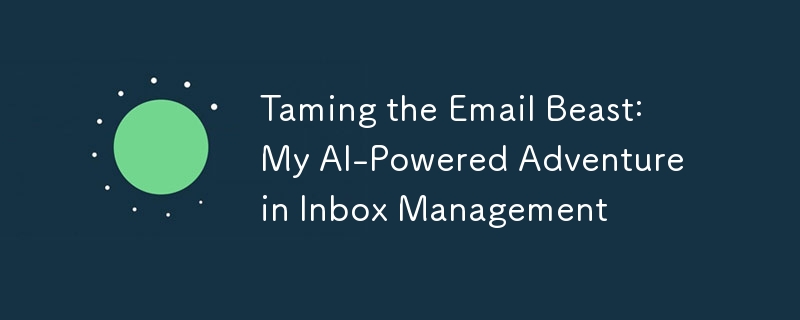馴服電子郵件野獸:我的收件匣管理人工智慧之旅

是否曾经感觉您的收件箱是一个数字九头蛇,为您回复的每个人发送两封新电子邮件? ??好吧,科技爱好者们,我决定用秘密武器来对付这个怪物:人工智能! ??️
尤里卡时刻
想象一下:现在是凌晨 3 点,我周围都是空咖啡杯☕☕☕,盯着一个数量可与国会图书馆相媲美的收件箱。就在那时,我突然想到——如果人工智能可以击败国际象棋大师,它肯定可以帮助我理清这个电子邮件迷宫,对吗?
输入 AI 电子邮件低语者
因此,我卷起袖子,投入到创建人工智能驱动的电子邮件处理系统中。可以把它想象成有一个不知疲倦、超级聪明、从不要求喝咖啡休息的实习生。以下是这个数字奇迹的工作原理:
全视之眼 ?️:使用强大的 GPT-4,我们的 AI 朋友扫描传入电子邮件的速度比您说“您收到邮件了!”还要快
排序帽 ?:然后它将每封电子邮件分类为“产品查询”或“订单请求”。这就像霍格沃茨,但用于电子邮件!
订单主控 ?:对于订单请求,它会比您单击“添加到购物车”更快地提取详细信息,并检查我们是否有足够的库存来履行订单。
圆滑的谈话者?:根据电子邮件类型和订单状态,它会制作个性化的回复,这会让莎士比亚嫉妒(好吧,如果莎士比亚从事电子商务)。
查询Queller ❓:对于产品查询,它发送自动回复的速度比您说“我们很快就会回复您”的速度还要快。
秘密酱料(又名技术堆栈)
对于所有编码行家来说,以下是我们人工智能厨房中正在烹饪的食物:
- 主课:Python? (因为谁不喜欢代码中的好蛇?)
- 特殊成分:OpenAI 的 GPT-4(语言模型中的 Gordon Ramsay)
- 配菜:熊猫? (用于数据处理,而不是用于咀嚼竹子)
- 调料:Google Sheets API(因为电子表格是数据存储的无名英雄)
让我们深入研究一些代码片段,看看它实际上是如何工作的!
1. 邮件分类
以下是我们如何使用 GPT-4 对传入电子邮件进行分类:
def classify_email(email_body: str) -> str:
prompt = (f"Classify the following email as either a 'product inquiry' or an 'order request'. "
"An 'order request' must include explicit purchase intent, such as specifying quantity, shipping details, or mentioning a transaction."
"General questions or interest in a product should be classified as a 'product inquiry'.\n\n"
f"Email: {email_body}\n\nClassification:")
response = client.chat.completions.create(
model="gpt-4",
messages=[{"role": "user", "content": prompt}]
)
classification = response.choices[0].message.content.strip().lower()
if "order request" in classification:
return "order request"
elif "product inquiry" in classification:
return "product inquiry"
else:
return "unclassified"
2. 订单处理
对于订单请求,我们提取详细信息并更新库存:
def process_order(email_id: str, orders: List[Dict], products_df: pd.DataFrame) -> Tuple[List[Dict], pd.DataFrame]:
order_status = []
for order in orders:
product_id = order['product_id']
quantity = order['quantity']
product = products_df[products_df['product_id'] == product_id].iloc[0]
current_stock = int(product['stock'])
if current_stock >= quantity > 0 and current_stock > 0:
status = "created"
products_df.loc[products_df['product_id'] == product_id, 'stock'] -= quantity
else:
status = "out of stock"
order_status.append({
'email_id': email_id,
'product_id': product_id,
'quantity': quantity,
'status': status
})
return order_status, products_df
3. 响应生成
最后,我们根据电子邮件类型和订单状态生成个性化回复:
def generate_response(email_name: str, classification: str, order_status: List[Dict], products_df: pd.DataFrame) -> str:
if classification.lower() == "order request":
context = "Order Summary:\n"
for order in order_status:
product = products_df[products_df['product_id'] == order['product_id']].iloc[0]
context = f"Customer name:{email_name} Product: {product['name']}, Quantity: {order['quantity']}, Status: {order['status']}\n"
prompt = f"""Generate a professional response for the following order:
{context}
If any items are out of stock, suggest alternatives or waiting for restock.
Ensure the tone is professional and enhances the customer experience.
Response:"""
else:
prompt = f"""Customer name:{email_name} \n Generate a professional response for a product inquiry.
Inform the customer that we've received their inquiry and will get back to them with more detailed information shortly.
Ensure the tone is professional and enhances the customer experience.
Response:"""
response = client.chat.completions.create(
model="gpt-4",
messages=[{"role": "user", "content": prompt}]
)
return response.choices[0].message.content.strip()
尤里卡时刻:我学到了什么
速度刺激 ⚡:快速确认电子邮件让客户比免费送货更满意(几乎)。
准确性为王?:微调人工智能提示就像教机器人跳舞一样——需要练习,但当它起作用时,那就太棒了。
库存俄罗斯方块?:实时库存检查使我们无法承诺无法交付的独角兽。
个人风格?:人工智能生成的个性化回复让客户感觉很特别,而我们又不会变成读心术者。
期待意外?:强大的错误处理使我们免于数字化面孔植物的次数比我愿意承认的要多。
证据就在布丁中(或者在本例中是收件箱)
在测试数据集上释放我们的人工智能电子邮件管理员之后:
- ?电子邮件响应时间比不带降落伞的跳伞运动员下降得更快(减少 80%)
- ?订单处理准确度像火箭一样猛增(提高了 95%)
- ?在编码期间,客户满意度的增加超过了我咖啡摄入量的增加(40% 提升)
人工智能电子邮件传奇的下一步是什么?
虽然这个项目是我的宠物实验(没有真正的宠物参与编码过程),但它打开了一个充满可能性的世界。想象一下客户服务忍者、电子商务奇才或生产力专家拥有如此人工智能的力量!
大结局
这种人工智能驱动的电子邮件冒险比狂看《硅谷》的所有季节更有趣(相信我,我已经做到了)。虽然它还没有准备好接管世界(甚至你的整个收件箱......),但它展示了人工智能如何改变我们处理数字通信的方式。
现在,我问你们,我的科技爱好者们:你们在项目中与人工智能共舞了吗?纠结于技术来提高生产力?我想在下面的评论中听到你的胜利(或搞笑的失败)故事!
记住:愿您的代码没有错误,并且您的收件箱为零! ??
你可知道? ?第一个电子邮件系统由 Ray Tomlinson 于 1971 年发明。如果他现在看到我们使用人工智能来管理电子邮件,他可能会说,“你已经……先进了!”
-
 如何將PANDAS DataFrame列轉換為DateTime格式並按日期過濾?Transform Pandas DataFrame Column to DateTime FormatScenario:Data within a Pandas DataFrame often exists in various formats, including strings.使用時間數據時...程式設計 發佈於2025-07-14
如何將PANDAS DataFrame列轉換為DateTime格式並按日期過濾?Transform Pandas DataFrame Column to DateTime FormatScenario:Data within a Pandas DataFrame often exists in various formats, including strings.使用時間數據時...程式設計 發佈於2025-07-14 -
 反射動態實現Go接口用於RPC方法探索在GO 使用反射來實現定義RPC式方法的界面。例如,考慮一個接口,例如:鍵入myService接口{ 登錄(用戶名,密碼字符串)(sessionId int,錯誤錯誤) helloworld(sessionid int)(hi String,錯誤錯誤) } 替代方案而不是依靠反射...程式設計 發佈於2025-07-14
反射動態實現Go接口用於RPC方法探索在GO 使用反射來實現定義RPC式方法的界面。例如,考慮一個接口,例如:鍵入myService接口{ 登錄(用戶名,密碼字符串)(sessionId int,錯誤錯誤) helloworld(sessionid int)(hi String,錯誤錯誤) } 替代方案而不是依靠反射...程式設計 發佈於2025-07-14 -
 如何將多種用戶類型(學生,老師和管理員)重定向到Firebase應用中的各自活動?Red: How to Redirect Multiple User Types to Respective ActivitiesUnderstanding the ProblemIn a Firebase-based voting app with three distinct user type...程式設計 發佈於2025-07-14
如何將多種用戶類型(學生,老師和管理員)重定向到Firebase應用中的各自活動?Red: How to Redirect Multiple User Types to Respective ActivitiesUnderstanding the ProblemIn a Firebase-based voting app with three distinct user type...程式設計 發佈於2025-07-14 -
 如何使用Python的請求和假用戶代理繞過網站塊?如何使用Python的請求模擬瀏覽器行為,以及偽造的用戶代理提供了一個用戶 - 代理標頭一個有效方法是提供有效的用戶式header,以提供有效的用戶 - 設置,該標題可以通過browser和Acterner Systems the equestersystermery和操作系統。通過模仿像Chro...程式設計 發佈於2025-07-14
如何使用Python的請求和假用戶代理繞過網站塊?如何使用Python的請求模擬瀏覽器行為,以及偽造的用戶代理提供了一個用戶 - 代理標頭一個有效方法是提供有效的用戶式header,以提供有效的用戶 - 設置,該標題可以通過browser和Acterner Systems the equestersystermery和操作系統。通過模仿像Chro...程式設計 發佈於2025-07-14 -
 C++20 Consteval函數中模板參數能否依賴於函數參數?[ consteval函數和模板參數依賴於函數參數在C 17中,模板參數不能依賴一個函數參數,因為編譯器仍然需要對非contexexpr futcoriations contim at contexpr function進行評估。 compile time。 C 20引入恆定函數,必須在編譯時進...程式設計 發佈於2025-07-14
C++20 Consteval函數中模板參數能否依賴於函數參數?[ consteval函數和模板參數依賴於函數參數在C 17中,模板參數不能依賴一個函數參數,因為編譯器仍然需要對非contexexpr futcoriations contim at contexpr function進行評估。 compile time。 C 20引入恆定函數,必須在編譯時進...程式設計 發佈於2025-07-14 -
 在JavaScript中如何並發運行異步操作並正確處理錯誤?同意操作execution 在執行asynchronous操作時,相關的代碼段落會遇到一個問題,當執行asynchronous操作:此實現在啟動下一個操作之前依次等待每個操作的完成。要啟用並發執行,需要進行修改的方法。 第一個解決方案試圖通過獲得每個操作的承諾來解決此問題,然後單獨等待它們: c...程式設計 發佈於2025-07-14
在JavaScript中如何並發運行異步操作並正確處理錯誤?同意操作execution 在執行asynchronous操作時,相關的代碼段落會遇到一個問題,當執行asynchronous操作:此實現在啟動下一個操作之前依次等待每個操作的完成。要啟用並發執行,需要進行修改的方法。 第一個解決方案試圖通過獲得每個操作的承諾來解決此問題,然後單獨等待它們: c...程式設計 發佈於2025-07-14 -
 如何使用FormData()處理多個文件上傳?)處理多個文件輸入時,通常需要處理多個文件上傳時,通常是必要的。 The fd.append("fileToUpload[]", files[x]); method can be used for this purpose, allowing you to send multi...程式設計 發佈於2025-07-14
如何使用FormData()處理多個文件上傳?)處理多個文件輸入時,通常需要處理多個文件上傳時,通常是必要的。 The fd.append("fileToUpload[]", files[x]); method can be used for this purpose, allowing you to send multi...程式設計 發佈於2025-07-14 -
 切換到MySQLi後CodeIgniter連接MySQL數據庫失敗原因無法連接到mySQL數據庫:故障排除錯誤消息要調試問題,建議將以下代碼添加到文件的末尾.//config/database.php並查看輸出: ... ... 迴聲'... echo '<pre>'; print_r($db['default']); echo '</pr...程式設計 發佈於2025-07-14
切換到MySQLi後CodeIgniter連接MySQL數據庫失敗原因無法連接到mySQL數據庫:故障排除錯誤消息要調試問題,建議將以下代碼添加到文件的末尾.//config/database.php並查看輸出: ... ... 迴聲'... echo '<pre>'; print_r($db['default']); echo '</pr...程式設計 發佈於2025-07-14 -
 如何在Java中正確顯示“ DD/MM/YYYY HH:MM:SS.SS”格式的當前日期和時間?如何在“ dd/mm/yyyy hh:mm:mm:ss.ss”格式“ gormat 解決方案: args)拋出異常{ 日曆cal = calendar.getInstance(); SimpleDateFormat SDF =新的SimpleDateFormat(“...程式設計 發佈於2025-07-14
如何在Java中正確顯示“ DD/MM/YYYY HH:MM:SS.SS”格式的當前日期和時間?如何在“ dd/mm/yyyy hh:mm:mm:ss.ss”格式“ gormat 解決方案: args)拋出異常{ 日曆cal = calendar.getInstance(); SimpleDateFormat SDF =新的SimpleDateFormat(“...程式設計 發佈於2025-07-14 -
 如何克服PHP的功能重新定義限制?克服PHP的函數重新定義限制在PHP中,多次定義一個相同名稱的函數是一個no-no。嘗試這樣做,如提供的代碼段所示,將導致可怕的“不能重新列出”錯誤。 但是,PHP工具腰帶中有一個隱藏的寶石:runkit擴展。它使您能夠靈活地重新定義函數。 runkit_function_renction_...程式設計 發佈於2025-07-14
如何克服PHP的功能重新定義限制?克服PHP的函數重新定義限制在PHP中,多次定義一個相同名稱的函數是一個no-no。嘗試這樣做,如提供的代碼段所示,將導致可怕的“不能重新列出”錯誤。 但是,PHP工具腰帶中有一個隱藏的寶石:runkit擴展。它使您能夠靈活地重新定義函數。 runkit_function_renction_...程式設計 發佈於2025-07-14 -
 Python元類工作原理及類創建與定制python中的metaclasses是什麼? Metaclasses負責在Python中創建類對象。就像類創建實例一樣,元類也創建類。他們提供了對類創建過程的控制層,允許自定義類行為和屬性。 在Python中理解類作為對象的概念,類是描述用於創建新實例或對象的藍圖的對象。這意味著類本身是使用...程式設計 發佈於2025-07-14
Python元類工作原理及類創建與定制python中的metaclasses是什麼? Metaclasses負責在Python中創建類對象。就像類創建實例一樣,元類也創建類。他們提供了對類創建過程的控制層,允許自定義類行為和屬性。 在Python中理解類作為對象的概念,類是描述用於創建新實例或對象的藍圖的對象。這意味著類本身是使用...程式設計 發佈於2025-07-14 -
 如何從PHP中的數組中提取隨機元素?從陣列中的隨機選擇,可以輕鬆從數組中獲取隨機項目。考慮以下數組:; 從此數組中檢索一個隨機項目,利用array_rand( array_rand()函數從數組返回一個隨機鍵。通過將$項目數組索引使用此鍵,我們可以從數組中訪問一個隨機元素。這種方法為選擇隨機項目提供了一種直接且可靠的方法。程式設計 發佈於2025-07-14
如何從PHP中的數組中提取隨機元素?從陣列中的隨機選擇,可以輕鬆從數組中獲取隨機項目。考慮以下數組:; 從此數組中檢索一個隨機項目,利用array_rand( array_rand()函數從數組返回一個隨機鍵。通過將$項目數組索引使用此鍵,我們可以從數組中訪問一個隨機元素。這種方法為選擇隨機項目提供了一種直接且可靠的方法。程式設計 發佈於2025-07-14 -
 如何實時捕獲和流媒體以進行聊天機器人命令執行?在開發能夠執行命令的chatbots的領域中,實時從命令執行實時捕獲Stdout,一個常見的需求是能夠檢索和顯示標準輸出(stdout)在cath cath cant cant cant cant cant cant cant cant interfaces in Chate cant inter...程式設計 發佈於2025-07-14
如何實時捕獲和流媒體以進行聊天機器人命令執行?在開發能夠執行命令的chatbots的領域中,實時從命令執行實時捕獲Stdout,一個常見的需求是能夠檢索和顯示標準輸出(stdout)在cath cath cant cant cant cant cant cant cant cant interfaces in Chate cant inter...程式設計 發佈於2025-07-14 -
 在Python中如何創建動態變量?在Python 中,動態創建變量的功能可以是一種強大的工具,尤其是在使用複雜的數據結構或算法時,Dynamic Variable Creation的動態變量創建。 Python提供了幾種創造性的方法來實現這一目標。 利用dictionaries 一種有效的方法是利用字典。字典允許您動態創建密鑰並...程式設計 發佈於2025-07-14
在Python中如何創建動態變量?在Python 中,動態創建變量的功能可以是一種強大的工具,尤其是在使用複雜的數據結構或算法時,Dynamic Variable Creation的動態變量創建。 Python提供了幾種創造性的方法來實現這一目標。 利用dictionaries 一種有效的方法是利用字典。字典允許您動態創建密鑰並...程式設計 發佈於2025-07-14
學習中文
- 1 走路用中文怎麼說? 走路中文發音,走路中文學習
- 2 坐飛機用中文怎麼說? 坐飞机中文發音,坐飞机中文學習
- 3 坐火車用中文怎麼說? 坐火车中文發音,坐火车中文學習
- 4 坐車用中文怎麼說? 坐车中文發音,坐车中文學習
- 5 開車用中文怎麼說? 开车中文發音,开车中文學習
- 6 游泳用中文怎麼說? 游泳中文發音,游泳中文學習
- 7 騎自行車用中文怎麼說? 骑自行车中文發音,骑自行车中文學習
- 8 你好用中文怎麼說? 你好中文發音,你好中文學習
- 9 謝謝用中文怎麼說? 谢谢中文發音,谢谢中文學習
- 10 How to say goodbye in Chinese? 再见Chinese pronunciation, 再见Chinese learning

























